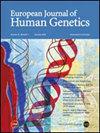fox3基因的新变异证实了其在眼-耳-椎谱中的意义。
IF 4.6
2区 生物学
Q2 BIOCHEMISTRY & MOLECULAR BIOLOGY
引用次数: 0
摘要
临床上异质眼-耳-椎谱或颅面小的分子基础仍然很大程度上未知。虽然在不到10%的患者中建立了遗传诊断,但FOXI3基因的变异是最常复发的遗传原因。我们研究了一个有4代6名患者的大家庭,显示出眼-耳-椎谱的常染色体显性遗传,不完全外显。基因组测序策略可以鉴定出位于FOXI3核定位信号内并影响其亚细胞定位的新的可能致病性错义变体。此外,我们还从251例眼-耳-椎谱患者的队列中发现了另外3例罕见的FOXI3变异。这些变体被归类为未知意义的变体。总之,本研究证实了FOXI3在眼-耳-椎谱中的意义以及核定位信号完整性的重要性。讨论了基因型-表型相关性和假定的修饰单倍型。本文章由计算机程序翻译,如有差异,请以英文原文为准。
Novel variants in FOXI3 gene confirm its implication in Oculo-Auriculo-Vertebral spectrum
Molecular bases of the clinically heterogenous Oculo-Auriculo-Vertebral Spectrum or Craniofacial Microsomia remain largely unknown. Although genetic diagnosis is established in less than 10% of the patients, variants in the FOXI3 gene are the most recurrent genetic cause. We studied a large family with 6 affected individuals on 4 generations showing an autosomal dominant transmission of Oculo-Auriculo-Vertebral Spectrum with incomplete penetrance. The genome sequencing strategy allowed the identification of a new likely pathogenic missense variant located within the Nuclear Localization Signal of FOXI3 and affecting its subcellular localization. Moreover, we described 3 additional rare FOXI3 variants identified in 3 other patients from a cohort of 251 patients with Oculo-Auriculo-Vertebral Spectrum. These variants were classified as Variants of Unknown Significance. In conclusion, this study confirms FOXI3 implication in the Oculo-Auriculo-Vertebral Spectrum and the importance of Nuclear Localization Signal integrity. Genotype-phenotype correlations and putative modifier haplotype are discussed.
求助全文
通过发布文献求助,成功后即可免费获取论文全文。
去求助
来源期刊

European Journal of Human Genetics
生物-生化与分子生物学
CiteScore
9.90
自引率
5.80%
发文量
216
审稿时长
2 months
期刊介绍:
The European Journal of Human Genetics is the official journal of the European Society of Human Genetics, publishing high-quality, original research papers, short reports and reviews in the rapidly expanding field of human genetics and genomics. It covers molecular, clinical and cytogenetics, interfacing between advanced biomedical research and the clinician, and bridging the great diversity of facilities, resources and viewpoints in the genetics community.
Key areas include:
-Monogenic and multifactorial disorders
-Development and malformation
-Hereditary cancer
-Medical Genomics
-Gene mapping and functional studies
-Genotype-phenotype correlations
-Genetic variation and genome diversity
-Statistical and computational genetics
-Bioinformatics
-Advances in diagnostics
-Therapy and prevention
-Animal models
-Genetic services
-Community genetics
 求助内容:
求助内容: 应助结果提醒方式:
应助结果提醒方式:


